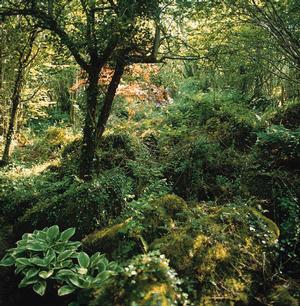Post category: Plants compete well with weeds
Weeds are a problem in every garden but if the competitive abilities of plants are used to the full extent, the chore of weeding can be greatly reduced.
Because a plant cannot move position to a more suitable place, it is forced to compete where it is growing. Competition for light and space takes place over ground, and for water and nutrients, below soil level.
Every plant competes for light, water and nutrients. Some are much better at the struggle than others. Trees, for example, are the top competitors, which explains how they managed to cover the Earth with dense forests – they would again, given the chance!

Plants compete well with weeds
The trunk of the tree holds the canopy of leaves higher than competing plants. In a mature broadleaf forest, the massive array of foliage traps eighty per cent of the sunlight and about the some proportion of rain. Down below, the smaller plants must get by with the remainder.
By way of complete contrast, tiny alpine plants are adapted for survival on the cold windswept slopes of mountains where, despite plenty of other difficulties, they have no competition. Their success depends on the ability to tolerate conditions that would kill other plants.
When they are planted in gardens without the harsh conditions to which they are adapted, they are easily swamped by bigger plants, even relatively small weeds such as annual meadow grass.
If we use garden plants to cover the ground and fill the available space, the plants we do not want – weeds – will not be as difficult, or as time-consuming, to deal with: that is the principle of ground cover.

Plants compete well with weeds
In a natural setting, there is rarely any bare soil to be seen. Even land slippages, and river banks stripped of vegetation by floodwaters, are quickly reclaimed. Any piece of bare ground is colonised by plants, especially the great opportunists of the plant world – the common weeds.
To clear the soil of weeds, and leave it bare, is to offer a further invitation which will be gratefully accepted. A general principle, the less bare soil in the garden, the less work of weeding. Bare soil can be covered up with desirable plants and mulches, or in some cases, it can be treated with chemical weedkillers.
All garden plants compete vigorously for space and resources. Trees, especially the large forest trees like oak, ash, beech, elm, lime, pine, horse chestnut, spruce and sweet chestnut, are very dominant, smaller trees less so but still capable of dominating in the absence of larger trees.
Shrubs are generally fast-growing and stake a claim to their space quickly. Perennial flowers do a lot of their competing below ground level by means of extensive roots. Annual flowers grow quickly to fill their allotted space.
It is important to realise that every plant, from the largest tree to small annual flowers, has potential for ground-covering. Very often, the term is applied only to low-growing, ground-hugging shrubs and perennial flowers. These are certainly good for the task, but it must be realised that all plants have this ability, if we care to use it.
For best results against weeds, one layer of plant ground cover is better than none, but two or more layers are even more effective.
Because plants have a hierarchy of size – large forest trees, smaller trees, shrubs, climbers, perennial flowers, annual flowers in that order – they arrange themselves under natural conditions in several layers of vegetation.

Plants compete well with weeds
In natural woodland, the top layer is the forest canopy of large trees. The under-storey layer contains the smaller trees like holly, yew, and hazel together with the trees of woodland clearings like cherry, hawthorn, crabapple and birch.
Lower again are the shrubs and climbers. Then, the perennial flowers and grasses that colonise the soil below ground with their extensive root systems, or bulbous roots. The last layer of all is the moss layer, usually ignored for garden purposes but it can be important. This consists of mosses, liverworts, lichens sometimes and small ferns. These compete for resources and can interfere with the germination of seeds of weed plants.
Each layer catches some sunlight for itself and thereby makes life more difficult for the plants below. We can use this feature of the competitive nature of plants to our advantage. Instead of setting up one layer of ground-cover plants to shade out weeds, why not have two or more layers?
The various layers of vegetation can easily be set up in garden woodland planting because it approximates to a natural woodland. Large gardens of two thousand square metres, or more, can easily accommodate some woodland planting.

The various layers of vegetation can easily be set up in garden woodland planting because it approximates to a natural woodland.
In any size of garden, mixed borders of trees, shrubs and perennial flowers compare to natural woodland edge, with shade-tolerant plants meeting those that enjoy full sunshine. It is possible to use the shade-tolerant kinds to underplant trees and shrubs, and to use the sun-lovers in front of the taller woody plants.


